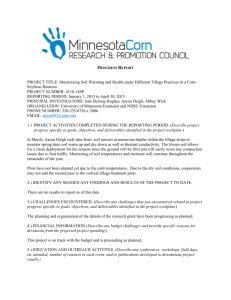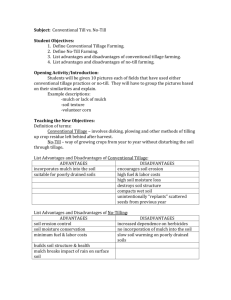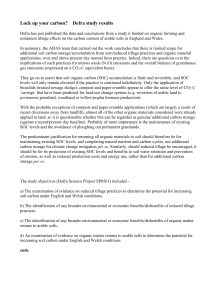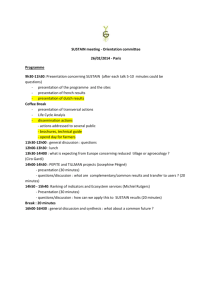KolodjazhnyiO
advertisement
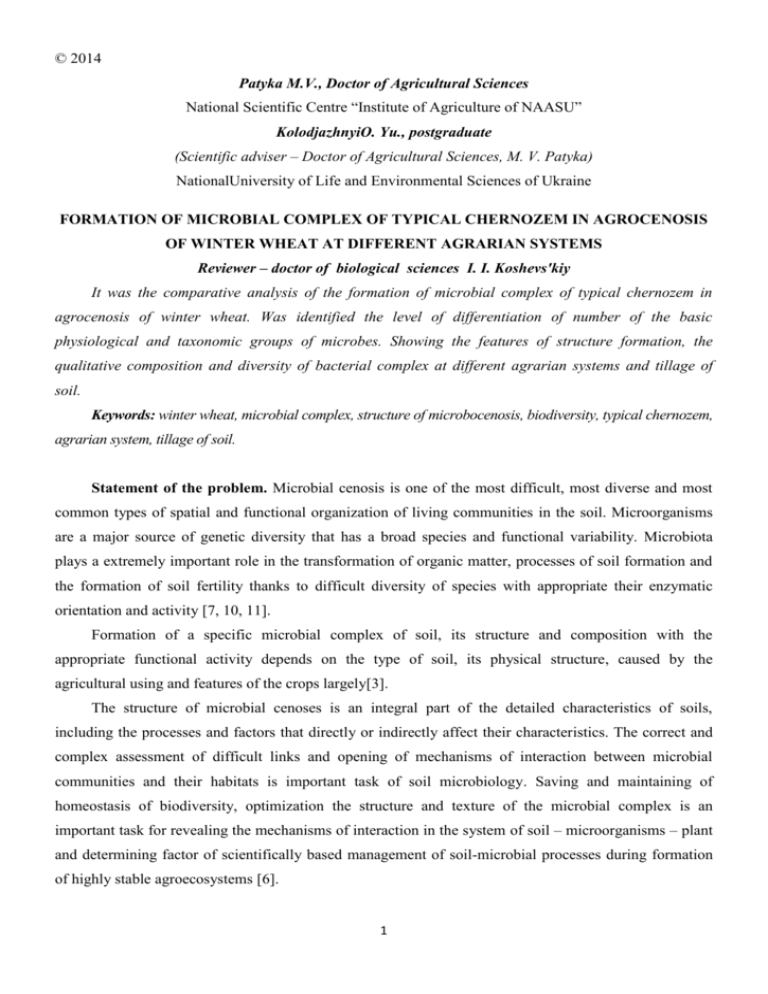
© 2014 Patyka M.V., Doctor of Agricultural Sciences National Scientific Centre “Institute of Agriculture of NAASU” KolodjazhnyiO. Yu., postgraduate (Scientific adviser – Doctor of Agricultural Sciences, M. V. Patyka) NationalUniversity of Life and Environmental Sciences of Ukraine FORMATION OF MICROBIAL COMPLEX OF TYPICAL CHERNOZEM IN AGROCENOSIS OF WINTER WHEAT AT DIFFERENT AGRARIAN SYSTEMS Reviewer – doctor of biological sciences І. І. Koshevs'kiy It was the comparative analysis of the formation of microbial complex of typical chernozem in agrocenosis of winter wheat. Was identified the level of differentiation of number of the basic physiological and taxonomic groups of microbes. Showing the features of structure formation, the qualitative composition and diversity of bacterial complex at different agrarian systems and tillage of soil. Keywords: winter wheat, microbial complex, structure of microbocenosis, biodiversity, typical chernozem, agrarian system, tillage of soil. Statement of the problem. Microbial cenosis is one of the most difficult, most diverse and most common types of spatial and functional organization of living communities in the soil. Microorganisms are a major source of genetic diversity that has a broad species and functional variability. Microbiota plays a extremely important role in the transformation of organic matter, processes of soil formation and the formation of soil fertility thanks to difficult diversity of species with appropriate their enzymatic orientation and activity [7, 10, 11]. Formation of a specific microbial complex of soil, its structure and composition with the appropriate functional activity depends on the type of soil, its physical structure, caused by the agricultural using and features of the crops largely[3]. The structure of microbial cenoses is an integral part of the detailed characteristics of soils, including the processes and factors that directly or indirectly affect their characteristics. The correct and complex assessment of difficult links and opening of mechanisms of interaction between microbial communities and their habitats is important task of soil microbiology. Saving and maintaining of homeostasis of biodiversity, optimization the structure and texture of the microbial complex is an important task for revealing the mechanisms of interaction in the system of soil – microorganisms – plant and determining factor of scientifically based management of soil-microbial processes during formation of highly stable agroecosystems [6]. 1 The aim of our research wasto study the features of formation the microbial complex oftypical chernozem in agrocenoses in winter wheat under different farming systems. Objective of research–to conduct a comparative characteristic the number of main physiological and taxonomic groups of microorganisms, analysis of the qualitative composition, structure and diversity of microbial complex of typical chernozem that formed in ontogenesis of winter wheat under different farming system. Materials and methods. Studies of microflora of typical chernozem conducted at the stationary field experiments of Department of Agriculture and Herbology NULeS of Ukraine. The area of studied field is located in the right bank of the Forest Steppe of Ukraine. The relief is flat. The soil of the field is the typical chernozem with low content of humus; granulometric composition is roughly dusty medium loam. The variants with resources supporting for playback a productive potential of agricultural landscapes are peculiarity of the studied farming systems. For industrial system – control(IS) making 12 tons of organic and 300 kg of active ingredient of fertilizers (N92P100K108) per hectare of arable land in the rotation. Protection of crops carries industrial pesticides. In the ecological model of agriculture (EC) priority is the use of organic fertilizers – 24 t/ha (12 tons of manure, 6 tons of non-commercial harvest (straw), 6 tons of green manure crop mass (radish) per hectare of crop rotation). The balance of power is compensated fertilizers (N46P49K35). The model of biological system (BS) is based on introducing 24 t/ha of arable land of organic fertilizers in crop rotation without the use of chemicals and using biological means of crop protection [9]. In the context of resource support options were studied system of differentiated (DT) and surface (ST) tillage of soil. Having taken and analysed of soil samples was carried out in a phase of flowering and wax ripeness of winter wheat from the top (0-20 cm) of arable layer of soil [2]. The number of microorganisms of different physiological and taxonomic groups was determined by the seeding of soil suspensions on elective solid culture media [2,8].Soil moisture was determined by thermostatic-weighing method. The qualitative composition of the microbial complex was studied on the basis of representation of cultural-morphological types. To determine the degree of dominance was used the indicator of saturation of species: % = (ах100)/А(a – number of colonies of certain morphotypes, A – total number of colonies) [1, 4]. Was calculated indices of Shannon (H) and Simpson (C) for the ecological assessment biodiversity of microorganisms in the soil[5]. Statistical analysis of the results was performed with the definition of the mean square deviations and confidence intervals in MS Excel. Results and analysis. According to the research it is established significant changes in the formation of number and structure of main physiological and taxonomic groups of microorganisms in ontogenesis of winter wheat under the influence of agrarian systems and soil tillage. 2 Thus, with respect to nitrogen forms in flowering phase of winter wheat (Fig. 1) the number of ammonifying bacteria in ecological and biological agrarian systems was higher in the 3 – 3,2 times, than in the industrial system. The quantity of microorganisms that using mineral forms of nitrogen at the surface tillage of soil ranged from 18,37 to 19,91 million CFU/g soil depending on the farming systems. Their numbers was significantly different and amounted 7,59 by industrial system,10,66 – by ecological,24,41 million – by biological, according to differentiated tillage. Fig. 1. The number of main physiological groups of microbial complex of typical chernozem in phase of flowering of winter wheat Increasing the quantity and correlation of ammonifying microorganisms and immobilizer of mineral nitrogen indicates that the processes of transformation of organic matter accelerated. Thus, mineral nitrogen included in the metabolism of microorganisms in particular by the ecological and biological systems. The conditions of competition of plants and microorganisms are generated for mineral nitrogen. As a result, in industrial agrarian system the number of oligonitrifying bacteria was 6,79 by the differentiated and 9,73 by surface tillage and increased to 19,03 and 18,22 million in the biological system accordingly. Number of cellulolytic microorganisms that actively operate in microbocenosis on the early stages of transformation of organic matter was different significantly in the investigated agrarian systems. Their number amounted to 462,45 thousand CFU/g at differentiated tillage, 505,21 at surface tillage by industrial system, by biological – 561,10 and 788,67 respectively tillage and increased significantly by 3 the ecological – 970,17 and 825,40 thousand, accordingly .Increasing the number of spore-forming bacteria of 2,5 took place at the ecological and almost 7 times at the biological agrarian system with differentiated tillage compared to industrial (0,87 and 2,67 million at differentiated and surface tillage of soil, respectively). This evidences about actively involved the aforecited groups in the process of transformation of organic remnants. There was an increase the number of streptomycetes to 3,05 – 3,92 million at ecological and biological agrarian systems.The number of micromicetes of typical chernozem increased in variants with priority using of organic fertilizers and was 49,86 – 60,35 thousand CFU/g of soil. By considerable difference in number of main physiological groups of microorganisms, to establish the functional differing vectors of microbiological processesthe quality and the structure ofdistribution dominant forms of soil microflora in variants of the experiment are very important. Generally, have been described 141morphotype of the bacteriain flowering stage of winter wheat (Fig. 2).There were 13 dominant, 23 subdominant, 89frequentand 16randomspecies. Agrarian systems and tillage of soil had a significant impact on the distribution of the different groups identified morphotypes. Thus, the structure of the bacterial complex included 4 dominant, 3 subdominant and 6 frequent species by industrial agrarian system with differentiated tillage of soil. There was increasingof frequent species in twice, was observed activationand inclusion random speciesin the structure of microorganismsby the surface tillage of soil. Fig. 2. Influence of agrarian systems and tillage on the quality of the prokaryotes of typical chernozem (flowering phase of winter wheat) Quantity of dominant bacterial morphotypes was reduced to 1 in the structure of the complex, but the number of frequent species in community increased significantly(80 and 54%, respectively) for ecological and biological agrarian systems, that characterizes increasing diversity of microbial cenosis. In the biological system observed activation of random shapes, which share amounted to 23% in 4 differentiated tillage and 26% - the surface tillage of the total morphotypes in the structure of the microbial complex. Was observed alignment the structure of microbial coenosis through redistribution of number the main physiological groups of microorganisms by variants of the experiment at the end seasonof winter wheat growing (Fig. 3). Fig. 3. The number of main physiological groups of microbial complex of typical chernozem in phase of wax ripeness of winter wheat Compared with the phase of flowering, the number of ammonifying microorganisms increased slightly, and was amounted 15,31 and 16,30 million depending on tillage of soil at ecological agrarian system. Their quantity did not change significantly and amounted to 13,91 and 12,08 million at biological system. There was an increase the number of ammonifying bacteria to 12,80 of differentiated and 11, 93 million of the surface tillage of soil by industrial farming system. The number of microorganisms, which use mineral nitrogen increased in the industrial system with differentiated tillage to 11,09 and 16,04 – with surface tillage and decreased to 11,91 for ecological system with surface tillage, and to 15,72 and 6,97 million according of tillage by biological system. Alignment the number of oligonitrifying bacteria in variants of the experiment was due to their increasing in industrial agrarian system (10,36 and 12,01) and decreasing in biological (12,09 and 8,01 million according to tillage).Should be noted increasing the number of oligotrophic microorganisms to 5 12,06 by industrial system with differentiated tillage and decreasing from 9,48 (at flowering stage of winter wheat) to 7,58 by the ecological system and from 25,7 to 7,1 million CFU/g of soil by biological system respectively. This is evidenced by the availability of easily digestible substances that accumulate during the transformation of organic remains of plants. This improves the formation of trophic relationships in microbial complex of soil and reduces the number of pedotrophic microorganisms in these variants of the experiment. Significant changes in the numbers of actinomycetes were not observed, their number was 2,22 – 4,08 million. Was noted increasing the number of spore-forming microorganisms at all variants of the experiment to 4,13 – 6,46 million in this phase of ontogenesis. Was observed decreasing and there distribution number of cellulolytic microorganisms in variations at the end season of vegetation the winter wheat. Abnormally high temperatures and lack of moisture were negative factors in this period. Thus, their quantity decreased by industrial farming system to 48,09 and 106,42 with differentiated and surface tillage, by ecological – to 71,30 and 44,66, and by biological – to 41,57 and 100,08 thousand accordingly. The number of micromicetes of typical chernozem did not change significantly and amounted 51,04 – 60,42 thousand CFU/g soil compared with the flowering phase of winter wheat. Organic matter of soil was accumulated at the expense by overground and underground biomass of plants in this phase of ontogenesis. Orientation of microbiological processes contributed to this and there was a significant increasing the number of identified morphotypes (Fig. 4). There were identified216 morphotypes. Among them, there were 3 dominant, 23subdominant, 150frequent and 40random species. For surface tillage of soil the dominant morphotypes of microbial complex structure was not found. Their share was 3,1% by industry, 2,6% by ecological and 2,5% by biological agrarian systems with differentiated tillage of soil. The main share of frequent microorganisms was 56 –66% by industrial, 63 – 66% by ecological and 72 – 89% by biological system according to tillage of soil. Fig. 4. Influence of agrarian systems and tillage on the quality of the prokaryotes of typical chernozem (wax ripeness phase of winter wheat) 6 Topology of distribution of revealed dominant form was significantly different by agrarian systems and tillage of soil. (Fig. 5). Fig. 5. Distribution of dominant bacterial morphotypes of typical chernozem depends by farming systems and tillage of soil The morphotypes 1, 2, 4 were specific only to the industrial agrarian system with differentiated tillage. Morphotypes 3 and 5 were found in industrial and ecological systems, 6 were specific only for industrial system with surface tillage of soil. Was formed a specific dominant microflora and for biological agrarian system (7-9 morphotypes). Were occurred species that have high antagonistic activity among the identified dominants, so they are promising for further research and using in biotechnology. The value and functional properties of the dominant members of the microbial complex are also important in direct relationship with the plants of winter wheat. Comparative evaluation of ecological indices of forming microbiota of typical chernozem showed a significant relationship between the biodiversity of the Shannon and Simpson's dominance in the different phases ontogenesis of winter wheat (Table 1). It was established that the increase of biodiversity and population of bacterial microflora occurs as follows in the flowering phase of wheat: IS + DT → IS + ST → BS + ST → BS + DT → ES + ST → ES + DT. Diversity index of the bacterial microflora was low and did not exceed 1 at industrial agrarian system. Simpson dominance index indicates the formation of a homogeneous microbial complex of typical chernozem with a high degree of dominance of some bacterial morphotypes by industrial agrarian system. 7 1. Ecological indices of biodiversity and dominance of bacterial complex of typical chernozem in agrocenoses of winter wheat Phase of wax Phase offlowering Agrarian system Industrial Tillage of soil ripeness Indexes Shannon Simpson Shannon Simpson Differentiated 0,96 0,13 1,37 0,05 Surface 1,19 0,08 1,34 0,06 Differentiated 1,38 0,05 1,47 0,05 Surface 1,37 0,05 1,48 0,05 Differentiated 1,27 0,07 1,49 0,04 Surface 1,24 0,07 1,50 0,04 Ecological Biological The increase of biodiversity index at the end of vegetation of wheat to 1,49 and 1,50 at biological agrarian system with differentiated and surface tillage was due to the accumulation of nutrient easy digestible substances for microorganisms in the soil. Application of industrial agrarian system leads to decreasing the diversity (1,34 and 1,37, respectively).Reducing the Simpson dominance index indicates to formation of stable homeostatic complexof soil microorganisms, which promote even distribution of species and expansion of the complexity and trophic relationships of microbial cenosis. Conclusions. Established that the application of ecological and biological agrarian systems allows to optimize of microbiological processes during the active vegetation of winter wheat. This contributes to create conditions for increase the number of ammonifying bacteria to 3 times, oligonitrifying – 1,8 – 2,5, microorganisms that use mineral forms of nitrogen – 2,4 – 3, spore-formingbacteria – 2,5 – 6,5,cellulolytic microorganisms – 1, 5 – 2 times and reduction the number of microorganisms that use mineral forms of nitrogen in the 1,5 – 2,3,oligotrophic – 1,5 and pedotrophic microorganisms – 1,5 – 1,7 times in wax ripeness phase of winter wheat. Formation of diversity of microbial complex,increasing of microbial species richness with few dominant forms and their equable distribution and high differing vectors of microbiological processes caused by the systematic application of organic fertilizers for playbackthe resource potential and scientifically justifies of tillage systems. The systematic applying of large quantities of chemical fertilizers leads to disruption of trophic relationships in the microbial complex, of structure of number the main physiological groups of microorganisms, of reducing biodiversity and the formation of a homogeneous microbioms of typical chernozem with a high degree of dominance of certain species of microorganisms. 8 Scientifically based using of principles of formation the microbial component of soil, preservation homeostasis of biodiversity, optimization the structure of microbial complex are the basis for various levels of technologies to improve of adaptive agrarian systems in the creation of highly stable agroecosystems and management of soil fertility in general. REFERENCES: 1. Emtsev V.T. Microbiology: textbook for Universities / V.T. Emtsev, E.N. Myshustyn. – 5th. – Moscow: Droffa, 2005. – P 205-206. 2. Zvyagintsev D.G. Methods of Soil Microbiology and Biochemistry / Ed. D.G.Zvyagintsev – Moscow: Publishing House of Moscow State University, 1991 – 330 p. 3. Iutinskaya G.A. Soil Microbiology / G.A. Iutinskaya. – K.: Aristej, 2006. – 284 p. 4. 4. Labutova N.M. Methods of study of soil microorganisms: textbook / N.M. Labutova. – St. Petersburg State University, 2008. – P. 13-16. 5. Odum J. Fundamentals of Ecology / ed. N.P. Naumov. – Moscow: Mir, 1975. – 733 p. 6. Patika M.V. Formation of biodiversity and phylotypical structure of eubacterial complex of chernozem at the winter wheat growing / M.V. Patyka, S.P. Tanchik, O. Yu. Kolodyazhny [et al] // Reports of National Academy of Sciences of Ukraine, – 2012. – № 11 – P.163-171. 7. Patyka N.V. Prokaryotic microorganisms of soil: structure and functional diversity / N.V. Patyka, Y.V. Kruglov, E.V. Shein // Abstracts of the XIII Congress of the Society of Microbiologists of Ukraine behalf of the S.N. Winogradsky. – Yalta, 2013. – P. 46. 8. Practicum on Microbiology: guidance for students of higher education institutions / A.I. Netrusov, M.A. Egorova, L.M. Zakharchuk [at al]. – Moscow: Publishing Center "Academy", 2005. – 608 p. 9. Tanchik S.P. Ecologіcal agrarian system in Forest Steppe of Ukraine / S.P. Tanchik, O.A. Demіdov, Y.P. Manko [at al] // Methodical recommendations for implementation into production. Kiev: NULeS of Ukraine, 2011. – 39 p. 10. Microbial diversity and soil functions / P. Nannipieri, J. Ascher, M. T. Ceccherini [et al]// European Journal of Soil Science. – 2003. – Vol. 54. – P. 655 – 670. 11. Microbial Diversity in Soils / B. Giri, P. Huong Giang, R. Kumari [et al] // Microorganisms in Soils: Roles in Genesis and Functions. – 2005. – P. 19 – 49 9
